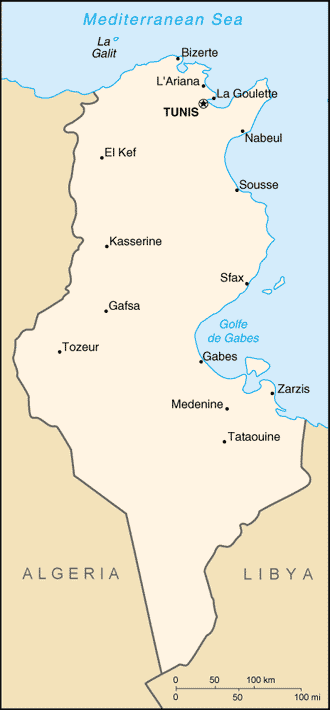 |
usa | world | animals | vocabulary | health | science | math | history |
Tunisia
Map Courtesy CIA World Factbook
At the beginning of recorded history, Tunisia was inhabited by Berber tribes. Its coast was settled by Phoenicians starting as early as the 10th Century B.C. In the 6th Century B.C., Carthage rose to power, but it was conquered by Rome (2nd Century B.C.), and the region became one of the granaries of Rome. It was held by the Vandals (5th cent. A.D.) and Byzantines (6th Century). In the 7th Century it was conquered by Arab Muslims, who founded Al Qayrawan. Successive Muslim dynasties ruled, interrupted by Berber rebellions. The reigns of the Aghlabids (9th Century) and of the Zirids (from 972), Berber followers of the Fatimids, were especially prosperous. When the Zirids angered the Fatimids in Cairo (1050), the latter sent in the Banu Hilal to ravage Tunisia. The coasts were held briefly by the Normans of Sicily in the 12th Century. In 1159, Tunisia was conquered by the Almohad caliphs of Morocco. They were succeeded by the Berber Hafsids (c.1230–1574), under whom Tunisia prospered. In the last years of the Hafsids, Spain seized many of the coastal cities, but these were recovered for Islam by the Ottoman Empire. Under its Turkish governors, the Beys, Tunisia attained virtual independence. The Hussein dynasty of Beys, established in 1705, lasted until 1957. In the late 16th Century the coast became a pirate stronghold (see: Barbary States). It was made a French protectorate on May 12, 1881. Tunisia became independent in 1956, and has had two presidents since.
|
||||||
 The Tunisian Republic, or Tunisia, is a Muslim Arab country situated on the North African Mediterranean coast. It is the easternmost and smallest of the three nations along the Atlas mountain range, bordering one of the others, Algeria to the west, as well as Libya to the south and east. Forty per cent of the country is comprised by the Sahara desert, with much of the remainder consisting of particularly fertile land and easily accessible coasts. Both played a prominent role in ancient times, first with the founding of the famous Phoenician city of Carthage, and later, as the Africa Province, it became known as the bread basket of the Roman Empire. It is thought that the name Tunis originated from Berber, meaning either a geographical promontory, or, 'to spend the night.'
The Tunisian Republic, or Tunisia, is a Muslim Arab country situated on the North African Mediterranean coast. It is the easternmost and smallest of the three nations along the Atlas mountain range, bordering one of the others, Algeria to the west, as well as Libya to the south and east. Forty per cent of the country is comprised by the Sahara desert, with much of the remainder consisting of particularly fertile land and easily accessible coasts. Both played a prominent role in ancient times, first with the founding of the famous Phoenician city of Carthage, and later, as the Africa Province, it became known as the bread basket of the Roman Empire. It is thought that the name Tunis originated from Berber, meaning either a geographical promontory, or, 'to spend the night.'